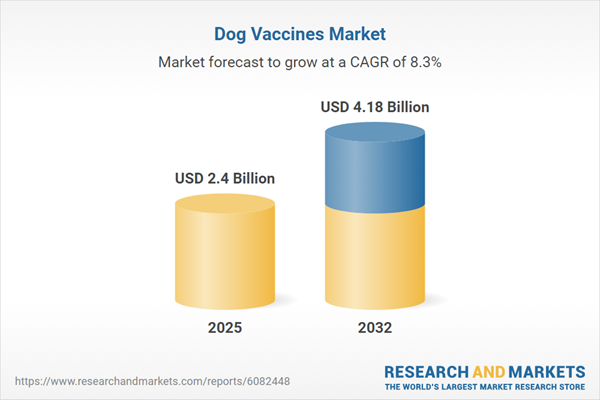Speak directly to the analyst to clarify any post sales queries you may have.
The global dog vaccines market is evolving rapidly, reflecting advances in vaccine technology, shifting regulatory approaches, and growing emphasis on animal health. Senior executives seeking to stay ahead of these trends will find strategic clarity in this comprehensive market intelligence resource.
Market Snapshot: Dog Vaccines Market Overview
The Dog Vaccines Market grew from USD 2.21 billion in 2024 to USD 2.40 billion in 2025. It is expected to continue growing at a CAGR of 8.26%, reaching USD 4.18 billion by 2032. This expansion is driven by increased global pet ownership, innovation in preventative medicine, and the integration of advanced vaccine platforms with targeted immunization protocols. Strategic investments and evolving distribution models are strengthening market accessibility across varied economies.
Scope & Segmentation
This report offers detailed analysis across multiple segments and regions, enabling targeted decision-making:
- Vaccine Type: Inactivated, Live Attenuated, Recombinant
- Distribution Channel: Animal Hospitals, Online Retail, Pharmacies, Veterinary Clinics
- End User: Pet Owners, Research Institutes, Veterinary Hospitals
- Technology: DNA, mRNA (Non-Replicating, Self-Amplifying), Vector
- Animal Age Group: Adult, Puppy, Senior
- Regions:
- Americas (United States, Canada, Mexico, Brazil, Argentina, Chile, Colombia, Peru)
- Europe, Middle East & Africa (including United Kingdom, Germany, France, Russia, Italy, Spain, Netherlands, Sweden, Poland, Switzerland, United Arab Emirates, Saudi Arabia, Qatar, Turkey, Israel, South Africa, Nigeria, Egypt, Kenya)
- Asia-Pacific (China, India, Japan, Australia, South Korea, Indonesia, Thailand, Malaysia, Singapore, Taiwan)
- Key Companies: Zoetis Inc., Merck & Co., Inc., Boehringer Ingelheim International GmbH, Elanco Animal Health Incorporated, Ceva Santé Animale S.A., Virbac S.A., Vetoquinol S.A., Dechra Pharmaceuticals PLC, HIPRA, S.L.U., Phibro Animal Health Corporation
Key Takeaways
- Technological breakthroughs such as mRNA, DNA, and viral vector platforms are redefining canine vaccine development, spurring the transition from traditional to next-generation products.
- The convergence of advanced vaccine delivery—injectable suspensions, intranasal sprays, and oral formulations—expands reach to rural and urban markets alike while enhancing safety and immunogenicity.
- Collaborative strategies among manufacturers, research institutes, and digital health providers are enabling faster validation cycles and streamlined regulatory approvals.
- Growing digitalization in distribution, including telemedicine, appointment management, and subscription-based vaccine delivery, is reshaping supply chain efficiency and consumer engagement models.
- Demographic-focused formulations and dosing schedules, particularly for puppies and older dogs, are driving diversification within product portfolios to address specific health needs.
- Regional adoption patterns highlight the importance of local partnerships and adaptability, with underlying drivers including regulatory harmonization, infrastructure investment, and education on preventative healthcare.
Tariff Impact
Adjustments to United States tariff schedules in 2025 have introduced increased production and transportation costs for canine vaccines. These shifts necessitate procurement realignment and supply chain resilience, with manufacturers turning to vertical integration and alternative sourcing to maintain competitive positioning. Strategic stockpiling, nearshore manufacturing, and internal process optimization have become essential in managing cost pressures and safeguarding product reliability for veterinary end users and pet owners alike.
Methodology & Data Sources
This study leverages comprehensive secondary research, including scientific journals, regulatory publications, and industry white papers. Structured interviews with veterinarians, research leaders, and logistics executives supplement the analysis, ensuring representation of real-world challenges and opportunities. Data triangulation and multistage validation safeguard the integrity of segmentation, technology assessment, and regional analysis, while peer review by industry specialists upholds objectivity.
Why This Report Matters
- Offers actionable insights to guide resource allocation, portfolio development, and partnership strategy in a rapidly evolving market environment.
- Enables C-level leaders to anticipate regulatory, technological, and regional shifts affecting the dog vaccines market, supporting agile risk management and long-range planning.
Conclusion
This report illuminates transformational shifts in the dog vaccines landscape, providing senior decision-makers with the clarity to drive effective strategies. Stakeholders can use these insights to build resilience, accelerate innovation, and enhance market penetration across global geographies.
Table of Contents
3. Executive Summary
4. Market Overview
7. Cumulative Impact of Artificial Intelligence 2025
Companies Mentioned
The companies profiled in this Dog Vaccines market report include:- Zoetis Inc.
- Merck & Co., Inc.
- Boehringer Ingelheim International GmbH
- Elanco Animal Health Incorporated
- Ceva Santé Animale S.A.
- Virbac S.A.
- Vetoquinol S.A.
- Dechra Pharmaceuticals PLC
- HIPRA, S.L.U.
- Phibro Animal Health Corporation
Table Information
| Report Attribute | Details |
|---|---|
| No. of Pages | 196 |
| Published | October 2025 |
| Forecast Period | 2025 - 2032 |
| Estimated Market Value ( USD | $ 2.4 Billion |
| Forecasted Market Value ( USD | $ 4.18 Billion |
| Compound Annual Growth Rate | 8.2% |
| Regions Covered | Global |
| No. of Companies Mentioned | 11 |









